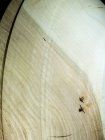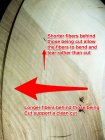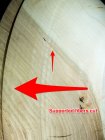First of all. I really did try searching for an answer here and on other sites, but since I don't know what it's called, that makes searching a little difficult.
I don't know what the marks shown in the photo below are called, what I'm doing that's causing them, or the best way to get rid of them. When I start sanding, I don't see them, but they show up as I'm going through the grits. I'm hand sanding, using a light touch, keep the sand paper moving, and I blow off the wood and clean with DNA between grits. This is a piece of cherry, but I've seen it on maple, cypress too. It's always in the end grain where you'd expect to see tearout.

What causes it? I'm keeping my tools sharp, don't think I'm riding the bevel too hard (or am I ?).
How do I prevent it?
How do I get rid of the marks that are there?
What the heck is it called?
I don't know what the marks shown in the photo below are called, what I'm doing that's causing them, or the best way to get rid of them. When I start sanding, I don't see them, but they show up as I'm going through the grits. I'm hand sanding, using a light touch, keep the sand paper moving, and I blow off the wood and clean with DNA between grits. This is a piece of cherry, but I've seen it on maple, cypress too. It's always in the end grain where you'd expect to see tearout.

What causes it? I'm keeping my tools sharp, don't think I'm riding the bevel too hard (or am I ?).
How do I prevent it?
How do I get rid of the marks that are there?
What the heck is it called?
Last edited:


